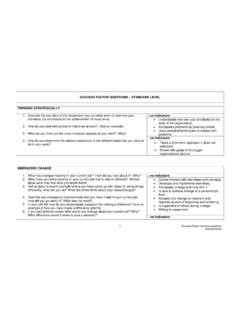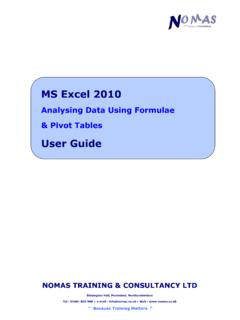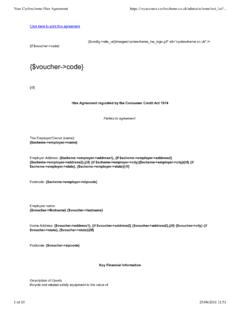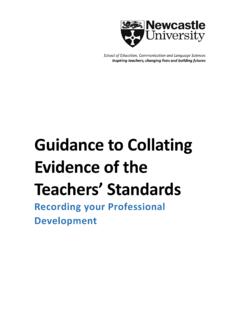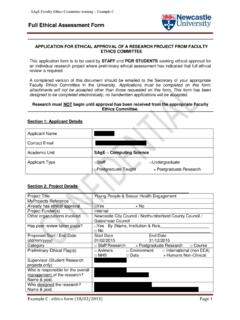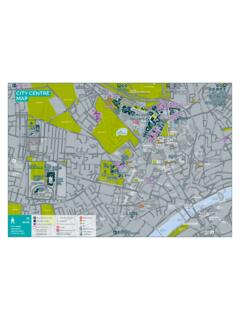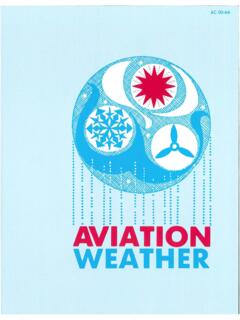Transcription of 3: RADIOMETRIC CORRECTION OF SATELLITE IMAGES: …
1 Lesson 3: RADIOMETRIC CORRECTION of SATELLITE images793: RADIOMETRIC CORRECTION OF SATELLITE IMAGES: WHEN AND WHY RADIOMETRIC CORRECTION IS NECESSARYAim of LessonTo demonstrate how to carry out the RADIOMETRIC CORRECTION of digital imagery, using two LandsatThematic Mapper images obtained at different seasons under different atmospheric conditions understand the difference between DN values, radiance and understand why RADIOMETRIC CORRECTION of imagery is required if mapping changes inhabitat or other features are, or will be, an objective or if more than one image is beingused in a demonstrate how different atmospheric conditions can affect DN values by comparingthese in two Landsat TM images acquired during different understand the concepts behind atmospheric CORRECTION carry out the process of RADIOMETRIC CORRECTION of the two Landsat TM images andcompare the resultant reflectance InformationThis lesson relates to material covered in Chapter 7 of the Remote Sensing Handbook for TropicalCoastal Management and readers are recommended to consult this for further details of the techniquesinvolved.
2 The lesson is rather a specialist one designed to guide practitioners in RADIOMETRIC andatmospheric CORRECTION ; it is advanced and is quite hard work (be warned!).Atmospheric CORRECTION will be carried out on two Landsat Thematic Mapper images of the CaicosBank obtained at different seasons and under somewhat different atmospheric conditions. The firstLandsat TM image was acquired in November 1990 whilst the second image (simulated) is for therather different atmospheric conditions and sun elevation of June 1990. At the time of the Novemberoverpass horizontal visibility was estimated at 35 km whilst for the June one it was only 20 km. The sunelevation angle for the winter overpass was 39 but that for the summer overpass was 58 . The DNvalues recorded for the same areas of the Earth s surface thus differ considerably between the Bilko for Windows image processing softwareFamiliarity with Bilko for Windows is required to carry out this lesson.
3 In particular, you will needexperience of using Formula documents to carry out mathematical manipulations of images. Somecalculations need to be performed independently; these can either be carried out on a spreadsheet suchas Excel or using a dataThe first image was acquired by Landsat 5 TM on 22nd November 1990 at hours Universal Time(expressed as a decimal time and thus equivalent to 14:33 GMT). The Turks & Caicos are on GMT 5hours so the overpass would have been at 09:33 local time. You are provided with bands 1 (blue), 2(green) and 3 (red) of this image as the files , , andApplications of SATELLITE and airborne image data to coastal These images are of DN values but have been geometrically corrected. The secondLandsat-5 TM image has been simulated for the rather different atmospheric conditions and sunelevation of 22 June 1990 at hours Universal Time by the reverse of the process you are learningto carry out in this lesson ( surface reflectance values have been converted to DN values at thesensor).
4 You are provided with bands 1 (blue), 2 (green) and 3 (red) of this image as the , and These images are also of DN values andhave been geometrically corrected so that pixels can be compared between seasons. The centre of eachscene is at N and underlying atmospheric correctionDigital sensors record the intensity of electromagneticradiation (ER) from each spot viewed on the Earth ssurface as a digital number (DN) for each spectral exact range of DN that a sensor utilises depends onits RADIOMETRIC resolution. For example, a sensor such asLandsat MSS measures radiation on a 0-63 DN scalewhilst Landsat TM measures it on a 0-255 the DN values recorded by a sensor areproportional to upwelling ER (radiance), the true unitsare W m-2 ster-1 m-1 (Box ).
5 The majority of image processing has been based on rawDN values in which actual spectral radiances are not ofinterest ( when classifying a single SATELLITE image ).However, there are problems with this approach. Thespectral signature of a habitat (say seagrass) is nottransferable if measured in digital numbers. The valuesare image specific - they are dependent on theviewing geometry of the SATELLITE at the moment theimage was taken, the location of the sun, specificweather conditions, and so on. It is generally far moreuseful to convert the DN values to spectral has two great advantages:1) a spectral signature with meaningful units can becompared from one image to another. This would berequired where the area of study is larger than a singlescene or if monitoring change at a single site whereseveral scenes taken over a period of years are ) there is growing recognition that remote sensing couldmake effective use of spectral libraries - librariesof spectral signatures containing lists of habitats andtheir reflectance (see Box ).
6 While spectral radiances can be obtained from thesensor calibration, several factors still complicate thequality of remotely sensed information. The spectralradiances obtained from the calibration only account forthe spectral radiance measured at the SATELLITE the time ER is recorded by a SATELLITE or airbornesensor, it has already passed through the Earth satmosphere twice (sun to target and target to sensor).Figure The process of of DNvalues to spectralradiance (at thesensor)Conversion ofspectral radiance toapparent reflectance(at the sensor)Removal ofatmospheric effectsdue to absorptionand scattering(atmosphericcorrection)DN values recordedby sensorReflectance of pixelsat the Earth's surfaceStep 1 Step 3 Step 2 Lesson 3: RADIOMETRIC CORRECTION of SATELLITE images81 Figure Simplified schematic of atmospheric interference and the passage ofelectromagnetic radiation from the Sun to the SATELLITE this passage (Figure ), the radiation is affected by two processes: absorption which reducesits intensity and scattering which alters its direction.
7 Absorption occurs when electromagnetic radiationinteracts with gases such as water vapour, carbon dioxide and ozone. Scattering results frominteractions between ER and both gas molecules and airborne particulate matter (aerosols). Thesemolecules and particles range in size from the raindrop (>100 m) to the microscopic (<1 m).Scattering will redirect incident electromagnetic radiation and deflect reflected ER from its path ( ).Box Units of electromagnetic radiationThe unit of electromagnetic radiation is W m-2 ster-1 m-1. That is, the rate of transfer of energy (Watt,W) recorded at a sensor, per square metre on the ground, for one steradian (three dimensional anglefrom a point on Earth s surface to the sensor), per unit wavelength being measured. This measure isreferred to as the spectral radiance.
8 Prior to the launch of a sensor, the relationship between measuredspectral radiance and DN is determined. This is known as the sensor calibration. It is worth clarifyingterminology at this point. The term radiance refers to any radiation leaving the Earth ( upwelling,toward the sensor). A different term, irradiance, is used to describe downwelling radiation reaching theEarth from the sun (Figure ). The ratio of upwelling to downwelling radiation is known asreflectance. Reflectance does not have units and is measured on a scale from 0 to 1 (or 0-100%).Absorption and scattering create an overall effect of haziness which reduces the contrast in the also creates the adjacency effect in which the radiance recorded for a given pixel partlyincorporates the scattered radiance from neighbouring order to make a meaningful measure of radiance at the Earth s surface, the atmospheric interferencesmust be removed from the data.
9 This process is called atmospheric CORRECTION . The entire process ofradiometric CORRECTION involves three steps (Figure ).The spectral radiance of features on the ground are usually converted to reflectance. This is becausespectral radiance will depend on the degree of illumination of the object ( the irradiance). ThusApplications of SATELLITE and airborne image data to coastal management82spectral radiances will depend on such factors as time of day, season, latitude, etc. Since reflectancerepresents the ratio of radiance to irradiance, it provides a standardised measure which is directlycomparable between data needed to carry out RADIOMETRIC correctionA considerable amount of additional information is needed to allow you to carry out the radiometriccorrection of an image .
10 Much of this is contained in header files which come with the imagery. Twotables of information relating to the Landsat TM imagery are included here whilst other information isintroduced in the lesson as needed. Table is extracted from the November 1990 Landsat TM imageheader, whilst Table contains some SATELLITE specific information you will In-band radiances from the TM header file, Lmin and Lmax in mW cm-2 valuesBandLmin Lmax Bandwidths for Landsat 4 and 5 Thematic Mapper sensors ( m).SatelliteTM1TM2TM3TM4TM5TM6TM7 Landsat 3: RADIOMETRIC CORRECTION of SATELLITE images83 Lesson OutlineComparison of the two Landsat image DN :Launch Bilko for Windows and open the geometrically corrected November Landsat TMimage bands 1-3. In the File, Open dialog box select , , and with the mouse and click on OK.
